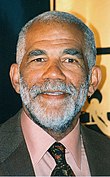User:MarSch/Main body
Today's featured article[edit]Ed Bradley (1941–2006) was an American broadcast journalist best known for reporting with 60 Minutes and CBS News. Bradley started his television news career in 1971 as a stringer for CBS at the Paris Peace Accords. He won Alfred I. duPont and George Polk awards for his coverage of the Vietnam War and the Cambodian Civil War. Returning to the United States, he became CBS's first Black White House correspondent. Bradley joined 60 Minutes in 1981 and reported on more than 500 stories with the program during his career, the most of any of his colleagues. Known for his fashion sense and disarming demeanor, Bradley won numerous journalism awards for his reporting, which has been credited with prompting federal investigations into psychiatric hospitals, lowering the cost of drugs used to treat HIV/AIDS, and ensuring that the accused in the Duke lacrosse case received a fair trial. He died of lymphocytic leukemia in 2006. (Full article...)
Recently featured:
Selected anniversaries[edit]July 5: Fifth of July in New York
|
In the news[edit]
Did you know...[edit]
Today's featured picture[edit]Cirsium palustre, the marsh thistle, is a herbaceous biennial (or often perennial) flowering plant in the family Asteraceae. It is native to Europe, where it is particularly common on damp ground such as marshes, wet fields, moorland and beside streams. In Canada and the northern United States it is an introduced species that has become invasive. It grows in dense thickets that can crowd out slower growing native plants. Cirsium palustre can reach up to 2 metres (7 ft) in height and features strong stems with few branches which are covered in small spines. In its first year the plant grows as a dense rosette and in subsequent years a candelabra of dark purple or occasionally white flowers, 10–20 millimetres (0.4–0.8 in) with purple-tipped bracts. In the northern hemisphere these are produced from June to September. The plant provides an important source of nectar for pollinators. This C. palustre flower was photographed in Niitvälja, Estonia.Photograph credit: Ivar Leidus
|





